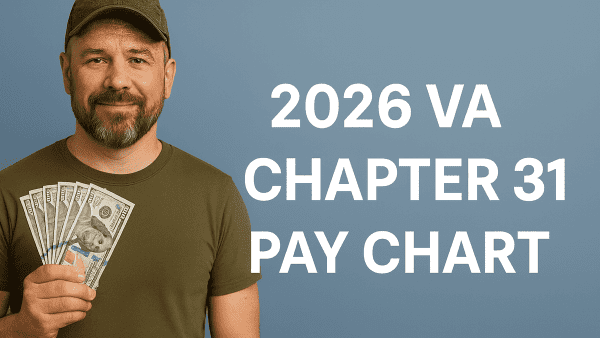Looking for Expert-Level VA Claim Answers?📱Call Us Now! 737-295-2226
After all the work that goes into filing a successful VA claim, followed by all the waiting for the VA to issue a decision, there are few things that feel better than finally having your claim approved, but can the VA reduce a PTSD rating? And can PTSD be considered a protected va disability rating?
The short answer is, yes. The VA absolutely can choose to reduce a PTSD rating after you’ve been rated.
So do not be surprised if, at some point, you receive a notice that they are proposing to reduce your benefits. This is because it’s been shown that 44% of adults eventually recover from PTSD to the point they no longer would receive a diagnosis.
With conditions that have the potential to improve, the VA will eventually want to check in on you to make sure you are not receiving benefits for a condition you no longer have, or that has improved.

Having said that, it’s important to know that it is not easy for the VA to do this. There are a number of Due Process Protections put into place by law that the VA must go through in order to finally determine that your rating should be reduced.
In other words, the VA must be able to prove that you have shown considerable improvement from the diagnosis they originally accepted to give you benefits.
So what does this process look like? Let’s break it down.
- How Can the VA Reduce a PTSD Rating?
- What To Do if You Receive Notice of Intent to Reduce a PTSD Rating
- 4 Things You Must Know Before You Attend Your C&P Exam at VA
- Ways to Secure your PTSD Benefits
- VA Disability Claims for PTSD – *LIVE* with Dr. Sally Sharp and VA Claims Insider
- If You Are Still Needing Help…
- About the Author
How Can the VA Reduce a PTSD Rating?
First of all, let’s talk about situations where you are almost fully protected from your benefits ever being reduced.
Protected Ratings
- Requiring Sustained Improvement
When your rating has remained at the same level for at least five years, the VA must show that all evidence displays continual improvement in your condition. In other words, they will have to look over your entire medical history for PTSD. Without proving sustained improvement, the VA can’t reduce your rating.
Frankly speaking, if your PTSD has only shown temporary improvement, your rating can’t be reduced.
- Fraud
If you have had the same rating for 20 years or more, the VA can’t reduce that rating except in cases where the VA can prove fraud. - Material Improvement
In order to reduce a PTSD rating of 100% (on an individual or combined rating), the VA must schedule an exam where they can determine that there has been an obvious material improvement in your condition.
If there is proven improvement, the VA must still determine whether or not you can qualify for TDIU (total disability).
Even if your PTSD rating doesn’t qualify for one of the “Protected Ratings” considerations, the VA still must take several steps before taking the action of reducing your benefits.
First, you will receive a notification letter of their intent to reduce your benefits. The money and benefits you receive will not be modified without warning.
Next, the VA is required to review your entire medical history before proposing a new rating or issuing a final decision, so a review must precede any decision. It must be proven that there has been an actual change in your PTSD condition since the previous rating was assigned.
In other words, the VA must be able to prove that there has been an improvement in your ability to function in normal work and life conditions.
Any examinations they conduct must be extremely thorough. This means a comprehensive review of your condition and how it affects your life. The VA cannot simply reduce your benefits based on anecdotal evidence or on their own whim.
What To Do if You Receive Notice of Intent to Reduce a PTSD Rating
It is required that the VA send you a letter informing you that they are proposing to reduce your benefits whenever the changes may decrease your monthly compensation. THIS IS NOT A FINAL DECISION.
After receiving the letter you will have an opportunity to respond to the proposal by submitting new evidence or attending a hearing. You have 60 days from the date of the letter to submit evidence and 30 days to request a hearing.
In fact, in the case you receive a letter of a potential rating reduction for your PTSD benefits, here are some steps you may take to prevent your rating from being reduced:
Steps to Prevent Your PTSD Benefits Rating from Being Reduced
1.Attend any scheduled examinations.
Re-examinations are generally ordered if there is evidence that your condition is likely to improve. This exam will usually be scheduled five years after your original rating decision. However, there are some instances where an examination should not be scheduled:
- Your condition is unchanging (usually PTSD would not qualify)
- Symptoms have not displayed any improvement for at least five years
- You are over 55 years of age
- Your PTSD rating is the minimum rating
- You have a combined rating that will not be affected
If you do not meet any of these standards, it is very important you show up for your examination unless you have very good cause and have attempted to reschedule. Otherwise you may have your benefits automatically reduced or, worse, completely discontinued.
Just like your original C&P exam, be sure to make the examiner aware of every symptom being re-evaluated. Don’t ignore or minimize any of them. Also, be sure to fully describe all the effects of your PTSD on your regular life and work.
2. Request a Hearing
You have a right to a hearing! As stated above, it must be requested within 30 days from receiving your notice in the mail.
If you request a hearing, your benefits will not be reduced until after the hearing has taken place. This gives you some extra time to gather what you need.
3. Review your Examination Report
Be sure to obtain the report of your examination in order to search for any inaccuracies reported by the examiner. You will want to know these discrepancies in order to present them at your hearing or to report them to the VA. This way, if the exam was inaccurate, you can request another one.
In order to grab a copy of your report, complete the form on VA.gov’s website. And to learn about how to have a successful P&T exam, watch the video below.
4 Things You Must Know Before You Attend Your C&P Exam at VA
4. Write a personal statement and potentially a buddy letter if appropriate
This may be especially important in regards to mental health issues like PTSD, bipolar disorder, or depression because it is much harder to objectively quantify their symptoms.
In the past, VA Claims Insider has discussed the buddy letter as well as the importance of Statements in Support of A Claim. While at one time we recommended buddy letters unhesitatingly, in our experience over time we’ve seen that buddy letters may not be necessary in most cases—and in some instances may actually complicate your claim.
5. If all else fails, APPEAL
Even with a hearing, a fair exam, and submitted evidence (such as buddy letters), you received a reduced rating. If this occurs, you can still appeal! You have one year from receiving the decision to file a Notice of Disagreement.
Doing so will enter you into the VA appeals process, where you still may have a chance of keeping your rating.
Ways to Secure your PTSD Benefits
PTSD is a mental health condition, so the rating the VA assigns to it for compensation benefits will largely be determined by subjective evidence. This can make it difficult to receive a high rating, and also make it difficult to prove you should maintain the rating you have already received when it’s time to be re-examined.
In this video, VACI Founder, Brian Reese, explains the process of filing a successful VA PTSD claim.
VA Disability Claims for PTSD – *LIVE* with Dr. Sally Sharp and VA Claims Insider
Therefore, when filing a PTSD claim, it can be very helpful to also have a secondary condition assigned to your claim as well. A couple of conditions that are often linked to PTSD are depression and bipolar disorder.
This is because it has been proven that people with mood disorders tend to experience more traumatic events or be more traumatized by a difficult event.
Depression and PTSD are often very closely linked. In fact, somewhere between 48%-55% of people with a diagnosis of PTSD have also experienced depression. Depression is considered one of the main symptoms of PTSD.
However, depression can also be so severe as to qualify for its own rating. Therefore its recommended that, when filing for PTSD, you also seek a secondary rating for depression if it has been affecting you.
In turn, this will also give the VA more to consider when proposing to reduce a PTSD rating.
Bipolar disorder and PTSD have also been proven to be linked, as bipolar patients have been shown to experience PTSD at a rate 6 times higher than the general population.

In the case that you are experiencing both of these conditions, it’s usually the case that the bipolar disorder is the initial condition. However, like depression, the link between the two is well-established.
Therefore it is not unheard of to receive a secondary rating combining PTSD and bipolar disorder. Which, again, will give the VA more to consider if they are looking to reduce a PTSD rating.
Of course, these are not the only options you have for receiving a secondary rating linked to PTSD. Depending on what you are experiencing, you will want to ask your medical professional what they recommend you seek a rating for.
The point is that, by receiving a secondary rating linked to PTSD, your chances of maintaining your benefits could be higher.
If You Are Still Needing Help…
If you’ve received notice of a proposed reduction in benefits, we have a team of VA Insiders who would love to help you!
Our team of professionals know the ins and outs of the VA system, and can help you be as prepared as possible in proving you deserve to keep your benefits.
About the Author

Elizabeth Hash
Elizabeth has served for her entire adult life, and has 20 years of combined skills in human resources, logistics, and organizational leadership.
Elizabeth joined the military at age 17 and completed basic training before her senior year of high school. She enlisted to follow her family tradition, as her father and three uncles served before her. Her career began in signal, led to logistics, and ended in recruiting in 2020. She was deployed to Kosovo in 2008, and served in Recruiting and Retention for the Missouri and Kansas Army National Guard from 2011-2020.



